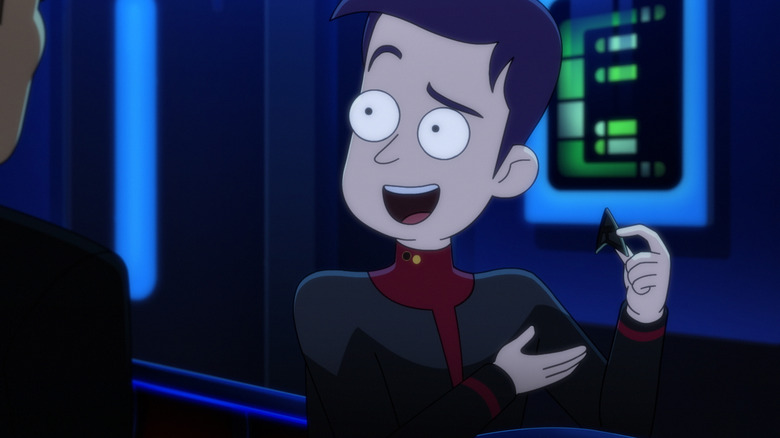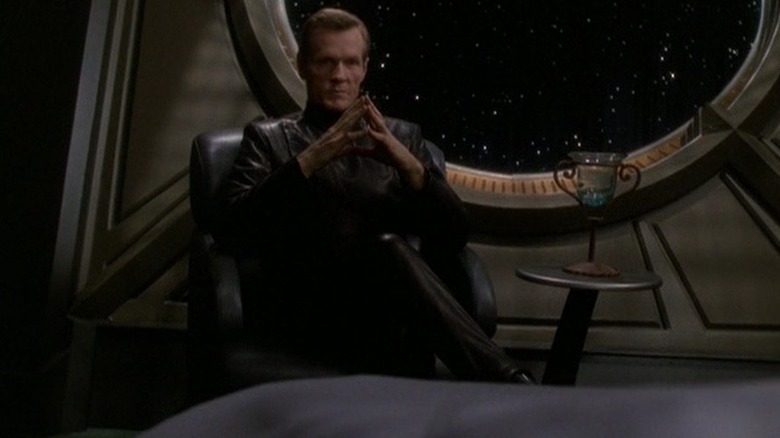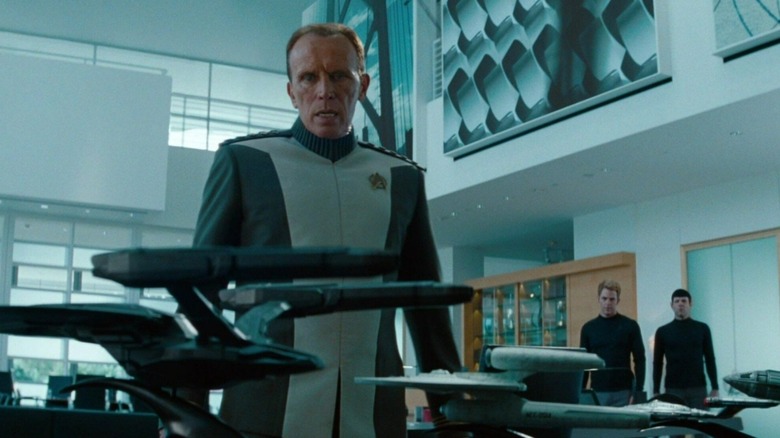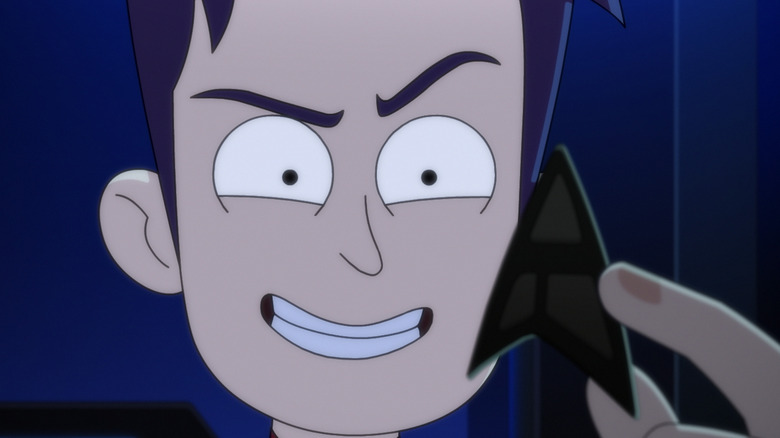The Dark Side Of The Star Trek Universe: Section 31 Explained
Major spoilers for the latest episode of "Star Trek: Lower Decks" will follow!
Every science fiction world — even (or especially?) the ones that seem like utopias on the outside — has its dark side. "Star Trek" has explored this in several different ways over its long history, from mirror universe shenanigans to morally ambiguous characters to freak transporter accidents, like the (mostly) unseen one at the center of this latest episode of "Lower Decks." But as much as the untimely "death" of Brad Boimler's (Jack Quaid) previously introduced clone William hangs heavy over the holodeck antics of "Crisis Point 2: Paradoxus," a sort-of sequel to the season 1 episode "Crisis Point," the knowingly angsty cliffhanger that closes out the final moments of this last episode references the franchise's most ambitious and divisive attempt to bring Starfleet's sterling ideals back down to our own level.
"Lower Decks" hasn't hesitated to put the very idea of Starfleet itself in its crosshairs on previous occasions, daring to go boldly and turn its ever-critical gaze inward to put a greater focus on thorny issues or tropes that have become commonplace over the years. In that light, it makes perfect sense that this animated series would finally set its sights on the shadiest subset of Starfleet ever added to the official canon: Section 31. The episode reveals that William Boimler didn't actually die from a terribly mundane accident and instead has been recruited to Section 31 for as-of-yet unknown purposes, setting the stage for a much larger presence in the series moving forward.
But what is the significance of Section 31, where did it originate from, and how will this stay faithful to what Trekkies expect from their favorite stories? I'm glad you asked!
Starfleet's dark twin
Time and time again, franchise icons like Captain Kirk, Picard, and all the rest have spent countless adventures upholding those good ol' Starfleet values and talking up the most optimistic vision of the future thanks to the United Federation of Planets. But as appealing and enduring as "Trek" creator Gene Roddenberry's intentions for this franchise may have been, how honest can it truly be without acknowledging the dark underbelly behind such a vast, structured, and blatantly militaristic hierarchy?
Enter Section 31, the "Trek" franchise's answer to those of a more realistic (though purists would likely say "cynical") bent who can't help but question whether Starfleet's mission of seeking out new life on alien worlds and getting involved in their affairs — almost always while flying around in super powerful warships armed to the teeth, to boot — ever really gelled with the aspirational tone of each movie and show.
Although relatively more modern installments like "Enterprise" and the J.J. Abrams film "Star Trek Into Darkness" further explored the mysteries behind the hush-hush espionage and intelligence offshoot of Starfleet, "Deep Space Nine" had the honor of officially introducing Section 31 into the fold as befitting the show's more nuanced, complex, and challenging approach to the material. The season 6 episode, titled "Inquisition," put a name to this faceless organization through the character of Luther Sloane (William Sadler), whom the writers used to propose the radical notion that Starfleet's dirty work was being done by outright villains — with their tacit endorsement, no less.
Where most adhere to the idea that the needs of the many outweigh the needs of the few, Section 31 shows how even the most logical of ideals can be twisted to dark and dubious purposes.
Dirty deeds
"Space, the final frontier." Every "Star Trek" fan knows the words by now, all of which collectively paint a picture of an unending universe full of potential and friendship just waiting to be discovered. Seeking out strange new worlds in the name of advancing the mutual goals of all involved is certainly a noble goal, but it's only human nature that even the most righteous causes would come crashing down despite our best intentions.
Section 31 is the embodiment of the age-old maxim that the ends justify the means, putting a fresh spin on the classic "Trek" trope of introducing moral quandaries for our heroes to somehow find a way to navigate as best they can. Throughout several movies and shows, we see Section 31 operatives do whatever it takes to advance their own ends while remaining separate (under chain of command, at least) from Starfleet and the Federation proper. In "Deep Space Nine," the shadowy black ops group resorts to blackmail, kidnapping, gaslighting, spying, and eventually even attempts at genocide to end the Dominion War that Starfleet was embroiled in. In "Enterprise," the organization remains unnamed but nonetheless bears all the overtones of the morally ambiguous (at best) and utterly remorseless (at worst) Section 31. The 2013 film "Star Trek Into Darkness" helped reestablish the dark side of "Trek" in mainstream pop culture, as the traitorous Admiral Marcus (Peter Weller) secretly orchestrates all the events involving Benedict Cumberbatch's Khan and imminent war with the Klingons to further Starfleet's military capabilities.
Until now, "Discovery" served as the last major example of "Trek" media delving into Starfleet's shady side, but now season 3 of "Lower Decks" seems poised to do the same — and perhaps answer at least one longstanding mystery along the way.
Tying it all together
"Lower Decks" may not seem to have as lofty ambitions as certain other ongoing franchise installments, opting instead for reference-heavy humor and cameos galore as opposed to weighty storytelling, but its latest episode may have just solved one narrative thread left hanging while introducing another.
Season 2 episode 2, titled "Kayshon, His Eyes Open," first introduced Boimler's twin who was created as a result of a transporter mishap. Almost immediately set at odds as a result of the clone's assignment on the prestigious USS Titan and his smooth rapport with the legendary "Next Generation" character William Riker, the Boimlers have likely remained on the backburner among the writers as a loose thread in need of addressing. That moment finally arrived with this last episode of "Lower Decks," which treated the clone's "death" as a catalyst to Brad Boimler's existential mental spiral ... until the last-second twist that set up a future storyline in which the clone and Section 31 will presumably factor in heavily.
But could the reappearance of Section 31 end up playing a role in another "Lower Decks" subplot altogether? Episode 5 went a long way toward reminding viewers of the murky origins surrounding fan-favorite character Rutherford (Eugene Cordero) and his cybernetic implants. In one of the show's few dramatic and serious storylines, we find out that a team of secret scientists — likely with Starfleet connections — instigated and covered up Rutherford's surgery for unknown but almost certainly nefarious reasons. Such a gross violation of human rights would easily fit the pattern established by Section 31, and the animated series has shown a willingness to "go there" (though to mixed results), so we'll have to wait and see whether these two disparate threads will, in fact, unite.



